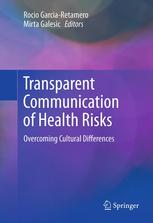

Most ebook files are in PDF format, so you can easily read them using various software such as Foxit Reader or directly on the Google Chrome browser.
Some ebook files are released by publishers in other formats such as .awz, .mobi, .epub, .fb2, etc. You may need to install specific software to read these formats on mobile/PC, such as Calibre.
Please read the tutorial at this link: https://ebookbell.com/faq
We offer FREE conversion to the popular formats you request; however, this may take some time. Therefore, right after payment, please email us, and we will try to provide the service as quickly as possible.
For some exceptional file formats or broken links (if any), please refrain from opening any disputes. Instead, email us first, and we will try to assist within a maximum of 6 hours.
EbookBell Team

4.8
94 reviewsRecent research in health decision making has shown that many patients, even those with a college education, have difficulties grasping a host of numerical concepts, including percentages and probabilities. Yet, basic numeracy and graph literacy are essential for understanding information relevant to making decisions about health, such as the incidence and prevalence of different diseases, risk reductions from medical screenings and treatments, and risk increases from side effects of treatments and unhealthy behaviors. Patients who have problems understanding such numerical concepts are often prone to errors in risk perception and medical choices. Importantly, informed medical decision making, heavily reinforced these days by the legal requirement for informed consent, depends critically on communication of quantitative medical information. Meeting the challenge of effectively communicating medical information to patients with different levels of numeracy and graph literacy has become more important than ever.
Transparent Communication of Health Risks describes a series of cross-cultural studies investigating how people in countries with different medical and educational systems understand numerical and graphical information, what they know about existing medical treatments and screenings, which presentation formats help them better understand the relevant information, and how they use the data to make medical decisions. Focusing on the careful measurement of necessary knowledge and skills, the book also includes validated numeracy and graph literacy scales in English, Spanish, and German. Some of the topics covered in the book are:
Transparent Communication of Health Risks emphasizes the importance and value of working toward the development of tailored risk communication interventions and clarifies the tasks ahead for health psychologists, public health professionals, pharmaceutical and medical education companies, medical physicists, and nurses.